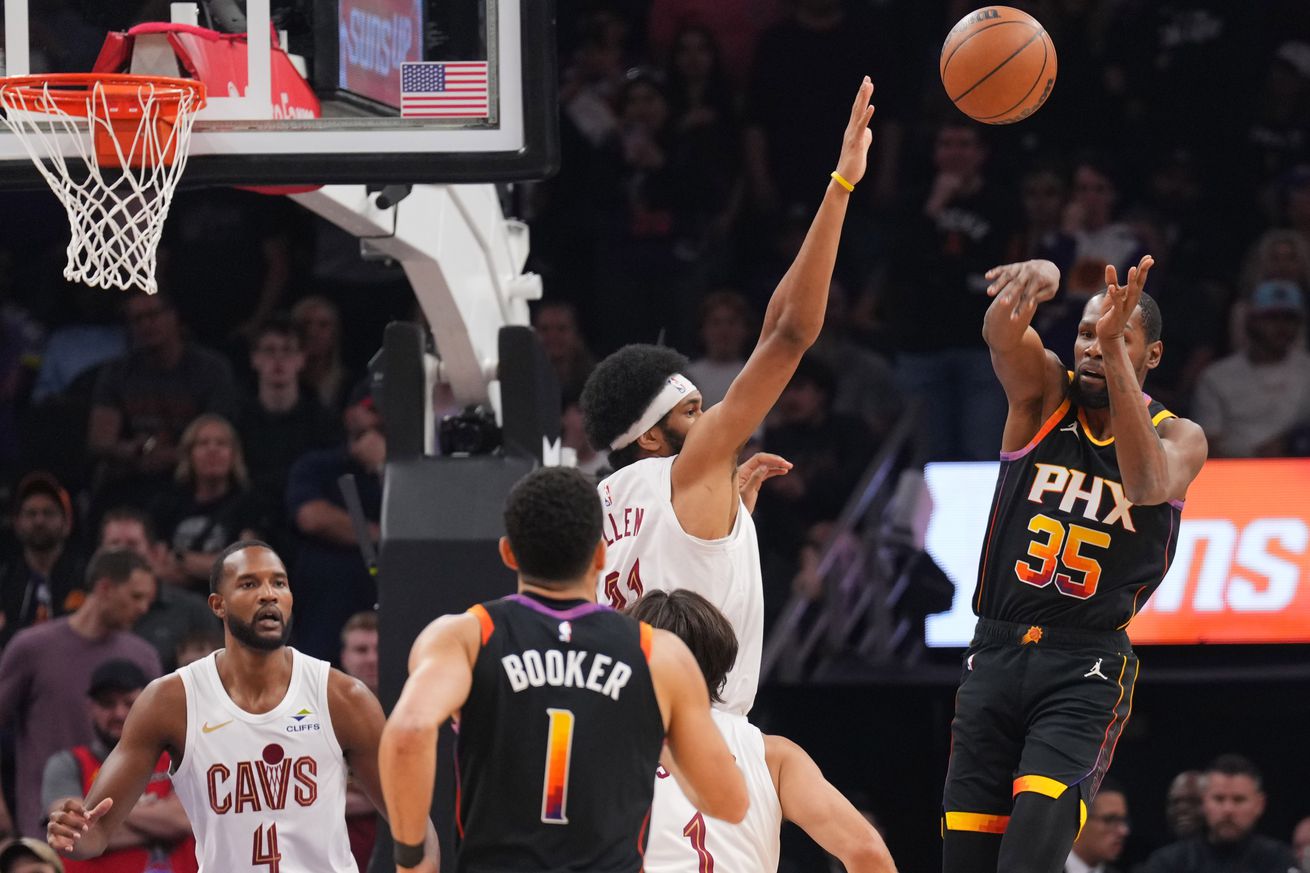
The Valley’s original franchise wasn’t fun to watch, and the offense was a bigger factor than the top-line numbers suggest.
During his April press conference, team owner Mat Ishbia aptly summarized the season in five little words: “It wasn’t fun to watch.”
This was a slog of a season. A vexing season. Watching the early championship chatter blow away like dandelion fluff was just the topper. The Phoenix Suns of 2024-25 played an exhausting brand of basketball…to watch. Logging a bottom-five defensive rating will do that. So will losing the fourth-most games in team history (13) when shooting 50 percent or better from the field and allowing their highest opponent field goal percentage ever in a game on Apr. 1 (68.9%).
Still, a team doesn’t have to be proficient defensively to be entertaining. People like scoring, and the 2024-25 Suns could score. Phoenix’s offensive rating was in the top half of the league and ranked as one of the top marks in franchise history. It finished 11th in field goal percentage (47.8), third in three-point percentage (37.8), second in free throw percentage (81.0), sixth in effective field goal percentage (56.1), and fourth in true shooting percentage (59.5).
areyounotentertained.gif
Well, it’s complicated. The Suns shot well, yes, but within an offense as free-flowing as a sorority shower drain. It seems impossible. Phoenix had three elite scorers on the team, sometimes even sharing the court at the same time, health and rotations permitting. So what had their Bugatti running on regular?
The nitty gritty
For one, the Suns took a lot of their shots against the shot clock. According to NBA.com (which provided the stats for most of this article), the Suns attempted 22.3% of their shots with seven seconds or fewer on the shot clock. Only the Brooklyn Nets (23.6%) dawdled to a greater degree.
Teams ideally shouldn’t be taking shots this late in the clock, as there is a well-established direct negative relationship between late shots and shooting percentages. Phoenix bucked the trend better than most, however, finishing fourth in the league relative to its overall season percentage when shooting between 7 and 4 seconds on the shot clock (-1.4 percentage points) and tops in the league when shooting between 4 and 0 seconds (-7.0 percentage points).
It’s a feather in the team’s cap that its elite shot-making bailed it out of so many inopportune situations. That doesn’t absolve it, though, of taking nearly a quarter of its shots this past season within the least efficient shot clock windows. A team with Kevin Durant, Devin Booker, and Bradley Beal is built to score; this number of late shots only kneecapped its greatest strength.
Even more concerning? This is the continuation of a trend.
In 2021-22, when Phoenix won a franchise-record 64 games, 15.9% of its attempts came in the final seven seconds of the shot clock — the lowest percentage by a Suns team in the data (dating to 2013-14). That number jumps to 17.7% in 2022-23 and 21.3% in 2023-24.
So why is Phoenix taking longer and longer to get shots at the basket?
Eagle-eyed readers may have noticed the upward trend in late-clock situations coincides with the arrival of Durant and, later, Beal. You’d be forgiven for believing the Suns have run an increasingly isolation-heavy offense with those players in the fold, but again, it’s not quite that simple.
Yes, the first full season of Booker/Durant/Beal saw the Suns run an isolation play 8.3% of the time, which was fifth-most in the NBA. But that dropped to 6.5% this season, good for 19th. The more interesting data comes from the two years prior.
In both 2021-22 and 2022-23, the Suns finished in the bottom five in the league, running isos less than five percent of the time.

That delineation between the Chris Paul era and the Big Three era appears elsewhere in the tracking data, too. Take time of possession (this counter does not reset until possession changes). In 2021-22, the average Suns possession lasted 20.2 seconds (top five shortest). By 2024-25, each possession lasted 21.5 seconds (bottom seven longest).
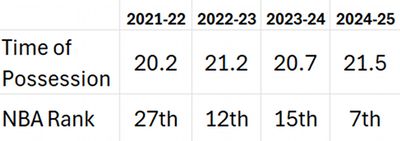
Or touches. In 2021-22, the Suns averaged 378.6 touches per game (second-fewest). By 2024-25, they were averaging 428.5 (fourth most).
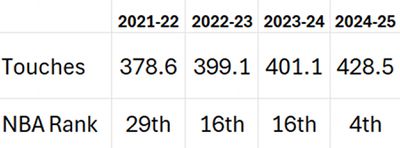
Or passes. In 2021-22, the Suns averaged 258.8 passes per game (28th) but 27.4 assists per game (fourth) for an assist-to-pass percentage of 10.6 (1st by nearly a full percentage point). By 2024-25, the Suns were averaging 307.6 passes per game (fourth) but 27.8 assists per game (10th), meaning just 9.0 percent of their passes resulted in an assist (21st).

Let’s try shot clock violations. 2021-22: 45 violations, tied for 25th in the NBA. 2024-25: 64 violations, tied for eighth in the NBA.
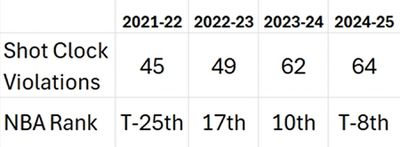
Or backcourt violations. 2021-22: Five violations, tied for 23rd. 2024-25: Twelve violations, tied for fifth.
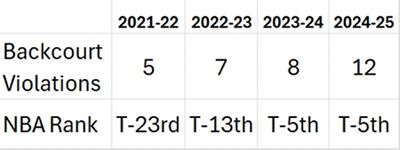
Or turnovers. 2021-22: 12.9 turnovers per game, seventh in the NBA. 2024-25: 14.1 turnovers per game, 15th in the NBA.
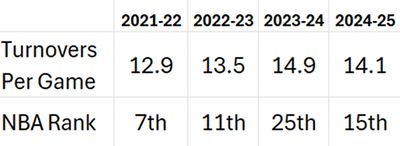
Since the 2021-22 season, the Phoenix Suns’ offensive efficiency and focus have both waned, a fact masked somewhat in the box scores by the superpowers of three of the best offensive players in the league.
Let’s point some fingers
There are likely several factors at play here. The most obvious: The Suns removed a first-ballot Hall of Famer from behind the wheel of the team’s offense. You can’t take Chris Paul away, replace him with score-first two guards or career backup point guards, and expect the same offensive fluidity. (Well, apparently you can if you work in the Suns’ front office.) That in and of itself is no indictment of those tasked with replacing Paul, though. Like with the perennial search for Steve Nash’s backup in the aughts, some players cannot be replicated.
That said, it is an indictment of the system(s) put in place after Paul’s departure.
Go back to those assist-to-pass percentages. The Chris Paul-led teams didn’t pass much, but they were at or near the top of the heap for assists. Those results flip-flopped these last two seasons, and that’s because, unlike when Paul was at the helm, passes are no longer made with the same purpose. There is no economy of action. Players are just moving the basketball. The same is true of the touches data. The Suns averaged 50 more touches per game this season than in 2021-22, yet averaged an insignificant 0.4 more assists for the trouble. That’s right. Over the years, the Suns have morphed into a professional Hot Potato club.
Chris Haynes, reporting shortly after former head coach Mike Budenholzer’s dismissal, stated that Budenholzer’s system “was a freedom offense. It was a random offense, and there was really no roles defined, particularly for the Big Three. It was like, ‘Guys, go out there and play. Go out there and figure it out.’”
Narrator: They didn’t figure it out.
What they did do was run an offense devoid of creativity but rich in predictability, with members of the Big Three either running a screen action or isolating against a mismatch on most trips down the court. If no clear shot presented itself, they might dish to a role player who, if he wasn’t open enough, would usually balk at creating his own shot in favor of passing back to one of the Big Three to re-rack another pick-and-roll or iso with the shot clock now running down.
Just as James Naismith envisioned, no doubt.
The tunnel vision theory of offensive execution even has a test case. The Suns in 2024-25 played exactly one game where none of Booker, Durant, and Beal took the court. That was the season finale against the Sacramento Kings. In that game, the Suns took 19 percent of their shots with seven or fewer seconds on the clock, a number solidly lower than the team’s season rate and the lowest of the four regular-season meetings between the two teams. The finale also saw the Suns attempt 57.1% of their shots within the window of 15 to 7 seconds, the range NBA.com considers average for a team. That is the highest percentage of the four meetings and well above the Suns’ season average of 47.7%.
Yes, Phoenix had nothing to play for, but the Kings did. The game had Play-In implications, and Sacramento played its regular rotation. They weren’t phoning it in. So while it was just one game at the end of the regular season, it lends credence to the argument that the Suns were too star dependent this season, as removing all three from the equation allowed for a more free-flowing offense, exactly what had been missing all season.
And here’s one final factor in Phoenix’s stagnation to consider: Deandre Ayton.
While mercurial and prone to lapses of, frankly, everything, Ayton provided Phoenix with a true lob threat, something the team has lacked since his trade to the Portland Trail Blazers before the 2023-24 season. Those alley-oops off the pick-and-roll were quick-hitting plays that didn’t eat much shot clock or require much passing to result in a good look. In other words: efficient.
The numbers suggest his importance in speeding up the halfcourt offense, too. During the 2021-22 season, Ayton took 10.6% of his shots with seven or fewer seconds on the shot clock. That’s the lowest percentage by that season’s regular starters. Meanwhile, a team-best 59.7% of his shots came within the “average” window of 15 to 7 seconds. It should be noted this isn’t apples to apples with the earlier shot clock data, since four other players could be attempting those late-clock shots besides Ayton. However, lineups containing Ayton also attempted, on average, fewer field goal attempts against the clock than ones that did not include him.
Fix it, already!
What’s to be done to return the dynamism to the offense?
It will all start with the new head coach GM Brian Gregory selects to lead the team. How this new hire goes about utilizing the roster he has (and not the roster he wishes he had) will determine whether new life is breathed into this stale squad. Stylistically, however, the new coach’s system would benefit from possessing a dash of Euro, with greater movement and cutting instead of specialists standing around waiting for the Big Three to create offense. The star-centric system the Suns have been running creates drag; the new coach needs to correct this imbalance with a system that empowers all five players on the court to be multidimensional. The less role players lean on the stars like a crutch, the more early offense can be generated.
This one seems obvious if the goal is to take fewer late shots, but the new coach must also get Phoenix playing at a faster clip. The Suns were miserable at getting out in transition last season, finishing 21st in pace and dead last in transition possessions. Yet, the Suns finished top eight in points per transition possession and top six in effective field goal percentage in transition. Put simply: When they ran, they scored. The team must spend more possessions running and fewer bogged down in the half court.
On the personnel front, the Suns desperately need a decider — a singular player entrusted to run the halfcourt offense. This player doesn’t have to be a point guard per se, but he does need to function as a hub. Chris Paul did that during his Suns tenure from the point guard spot, but Nikola Jokic, Domantas Sabonis, and Draymond Green all do the same from frontcourt positions. Phoenix didn’t have that this year, instead running a platoon of decision-makers out there. That bred indecisiveness. Too many chefs in the Valley kitchen. Perhaps Tyus Jones would have been more effective in such a system, acting as a low-turnover facilitator in a motion offense. Maybe Vasilije Micic would have made for a useful backup in that same system, considering his prolific EuroLeague experience. Too late now.
While on the topic of facilitators, no more Point Book. Ever.
Booker is a capable passer, but he still thinks too much when orchestrating the offense, struggles with traps, and tends to dribble himself into trouble. He is an elite scorer, and his elite skills should not be playing second fiddle to his adequate ones. This past season saw a career-high number of Booker’s drives to the basket result in passes instead of shots or fouls drawn. Like with Jones, Booker was asked to deviate from what he does best, and like Jones, he was a lesser player for it.
That brings us to the hole at the five. Phoenix must sniff out a center who is a bona fide lob threat in the two-man game and can improve the Suns’ number of paint touches — another area that has fallen off markedly with the departure of Ayton, going from 26.4 in his final season (1st in the NBA) to 18.3 last season (28th in the NBA). Having someone in the fold who can punctuate possessions at the rim will provide both efficient paint attempts and suck in defenses to free up shooters. That this player will also likely plug gaping holes defensively and on the glass is gravy.
And it should go without saying that shoring up the team’s legion defensive issues will result in positive knock-on effects for, well, everything.
Ishbia vowed in that April presser that Suns fans “will enjoy watching our team much better next year.” These steps would go a long way toward making that statement reality. How does all that get done this summer? Beats me. I didn’t attend Michigan State.
Listen to the latest podcast episode of the Suns JAM Session Podcast below. Stay up to date on every episode, subscribe to the pod on Apple, Spotify, YouTube, YouTube Podcasts, Amazon Music, Podbean, Castbox.
Please subscribe, rate, and review.